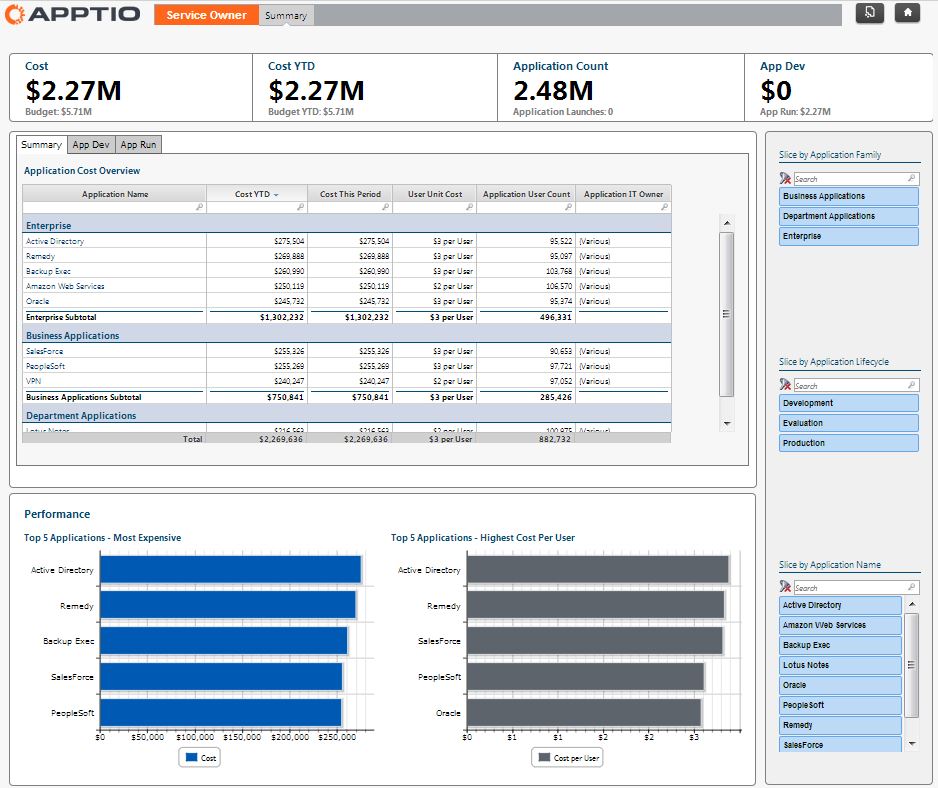Sponsored
Pragmatic Enterprise Application Rationalization
Provided byApptio
Application sprawl is a scourge that silently sucks IT resources and budget away from innovative business initiatives. Business users want IT leaders to support more and more apps with fewer resources. But these business users rarely know how much it costs to maintain an application.
And IT professionals aren’t very well equipped to tell them. CIOs often don’t know how many applications have been deployed, which applications are critical to the business mission, or how much it costs to run the enterprise’s application portfolio. They can’t say for sure which apps should be retired, replaced, moved to the cloud, or invested in.
Apptio can help you get the information you need for launching a successful application rationalization initiative, developing a framework for managing applications, and getting the necessary buy-in from business users.
Take the case of Park Nicollet Services. With technology demands mounting, costs climbing, and its network of health care providers expanding, Park Nicollet was looking for a solution to increase IT cost transparency and efficacy. After implementing Apptio to produce a “Bill of IT,” Park Nicollet was able to identify and eliminate 24 underutilized, misconfigured, or ineffective applications. This allowed the CIO to free up resources to drive further innovation within IT while aligning with the company’s larger business strategy.
Deep cost analysis can be too slow and expensive to cover enough of the app portfolio to make a meaningful impact. It may take a month or more to manually calculate the total cost of ownership (TCO) of a single application, and it’s usually too complex to use a spreadsheet to create a compelling TCO model for all applications.
Faster TCO analysis means oversimplification: either ignoring the fixed and variable costs necessary for computing ROI when apps are retired, or conducting a point-in-time TCO analysis that quickly becomes out of date and is usually not adequately followed up to ensure that app rationalizations are carried out and measured.
In most scenarios, for application rationalization to really work, the CIO and the IT department need a repeatable and systematic approach that makes business sense out of the disconnected financial, operational, and project data that surrounds application portfolios. This means automating the monthly process that transforms raw financial and IT data into an analysis of each individual application’s total cost, usage, and value.
When embraced and adopted, this process helps drive fact-based conversations between the CIO and business users based on shared data, and it helps business users quickly answer many of their own questions with interactive dashboards. Application costs become more defensible and trusted as stakeholders explore different dimensions with self-service analytics. And, finally, this process helps demonstrate potential and realized financial gains from application rationalization to justify additional funding for future IT projects.

The bottom line is that application sprawl is a significant and ongoing problem in the enterprise today. But CIOs can come out on top here – and gain the trust of business users – if they can truly demonstrate each application’s complete cost on a regular and consistent basis.
To read Gartner’s Application Rationalization Key Initiative Overview report, please visit http://info.apptio.com/resource-center_analyst-report_registration_ApplicationRationalizationKeyInitiativeOverview.html
To read Apptio’s Application Rationalization: Accelerate better decisions for cost reduction, agility & innovation solution brief, please visit: http://info.apptio.com/resource-center_analyst-report_registration_ApplicationRationalization.html
Keep Reading
Most Popular
Large language models can do jaw-dropping things. But nobody knows exactly why.
And that's a problem. Figuring it out is one of the biggest scientific puzzles of our time and a crucial step towards controlling more powerful future models.
The problem with plug-in hybrids? Their drivers.
Plug-in hybrids are often sold as a transition to EVs, but new data from Europe shows we’re still underestimating the emissions they produce.
Google DeepMind’s new generative model makes Super Mario–like games from scratch
Genie learns how to control games by watching hours and hours of video. It could help train next-gen robots too.
How scientists traced a mysterious covid case back to six toilets
When wastewater surveillance turns into a hunt for a single infected individual, the ethics get tricky.
Stay connected
Get the latest updates from
MIT Technology Review
Discover special offers, top stories, upcoming events, and more.